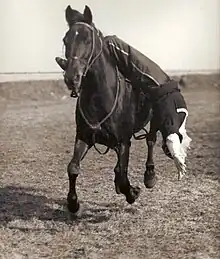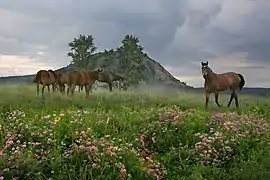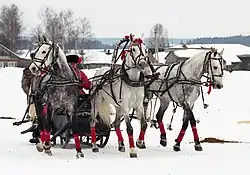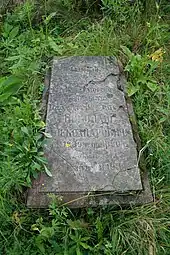 Trick riding demonstration, 1950s | |
The presence of horses in Russia is attested by prehistoric fossils and has been constant throughout its history, particularly during the Soviet era, thanks to the integration of territories with a strong equestrian tradition. Trick riding stems from the military traditions developed by the Russian Cossacks. Russian equestrian culture is characterized by the exclusive use of the "duga" yoke, known in particular through the troika.
History
According to Carole Ferret, the history of the horse in Russia has long been the prerogative of Soviet researchers that came from the territory under study, and as a result, is little known due to a "cruel lack of material".[1] Equine fossils dating from the Plio-Pleistocene have been found at Liventsovka, near Rostov-on-Don.[2]
In Imperial times and shortly thereafter, horse breeding was generally practiced by peasants, for whom it was the only resource. Horse theft was as frequent as it was feared. Numerous sources mention lynchings of thieves recognized by the population.[3] At the time of the USSR, there were territories with a strong equestrian tradition, notably Yakutia, Kazakhstan, Turkmenistan, and Kyrgyzstan, as well as Buryat populations.[4] Whether or not horses from conquered territories were integrated into the Russian army is a matter of debate.[5] The equestrian culture of the Cossacks, accustomed to riding freely and displaying great agility,[6] is inseparable from the military practices at the origin of trick riding.
Breeding

Russia is home to a significant number of horse breeds. The University of Oklahoma's work lists 64 different horse breeds bred in the country during the Soviet Union.[7] Including extinct horses and Przewalski's horse (which is not a breed), the FAO lists 69 horse breeds present or formerly present on the territory of the Russian Federation.[8]
Among the best-known breeds, the Don horse is traditionally associated with the Don Cossacks, who bred it from crosses with oriental horses as early as the 16th century. It owes much of its fame to its role in the Don Cossack victories over Napoleon's armies in 1812 and 1814. The French horses suffered from a climate to which they were not accustomed, whereas the Don horses were selected to withstand the Russian winter.[9]
In 1948, the Russian Federation had 15 horses for every 100 inhabitants. This figure reveals major disparities between regions of the USSR: the number rises to 34 in Buryatia and 50 in Yakutia.[10]
Applications

The Russians and Yakuts use four-wheeled horse-drawn vehicles named "telegas" for driving. The Russian "douga" yoke (named after one of its parts) is best known for one of its forms, the troika. It was first documented in the 16th century. It is characterized by the douga, an elastic wooden arch connecting one stretcher to the other over the withers, whose role is to keep the stretchers apart. The douga is used exclusively in Russia. It has the advantage of making better use of the horse's strength, and the disadvantage of not allowing more than one horse to be hitched (on a troika, only the middle horse wears the douga).[11]
Russians are not traditionally horse-eaters. They are gradually integrating populations for whom horsemeat consumption is customary, such as the Yakuts. This encounter did not lead to a ban on horsemeat in the Sakha, but rather to a "partial conversion of the Russians to horse-eating", as the Russians established in the region gradually began to eat it.[12]

Patrimony
Russia is home to the Imperial Horse Graveyard, probably the largest horse cemetery in the world. Active from 1834 to 1915, the cemetery fell into disrepair during the Soviet era. The French writer Jean-Louis Gouraud, who rediscovered it, has undertaken to raise funds for its restoration.[13]
The Central Moscow Hippodrome, one of the largest in Russia and the oldest in Europe, organizes renowned trotting races, hosts research and experimental teams on horse breeding and houses a riding school.[14]
Culture
The tale of The Little Humpbacked Horse, written in 1834 by Pyotr Yershov based on Russian folklore, is the inspiration for a ballet and an animated film.
 Caught in the storm, painting by Nicolas Swertschkoff (1950)
Caught in the storm, painting by Nicolas Swertschkoff (1950) Drawing from the tale "The Little Humpbacked Horse"
Drawing from the tale "The Little Humpbacked Horse"
Nicolas Swertschkoff (1817-1898) notably specialized in horse painting, particularly equestrian portrait.[15] He particularly mastered the animal's anatomy and expressions.[16] The "Russian sculptor of the horse" Evgueni Alexandrovitch Lanceray (1848-1886), "one of the best horse portraitists in the world", produced 400 works, half of which were on the theme of his favorite animal, and inspired the American Frederic Remington. Remaining in the shadows but passionate about his subject, he owned around twenty horses at his home in Neskoutchnoïe.[17]
See also
References
- ↑ Ferret 2009, p. 15
- ↑ Forsten, Ann (January 1998). "The fossil horses (Equidae, Mammalia)from the Plio-Pleistocene of Liventsovka near Rostov-Don, Russia". Geobios. 31 (5): 645–657. Bibcode:1998Geobi..31..645F. doi:10.1016/S0016-6995(98)80052-1.
- ↑ Worobec, Christine D. (1987). "Horse Thieves and Peasant Justice in Post-Emancipation Imperial Russia". Journal of Social History. 21 (2): 281–293. doi:10.1353/jsh/21.2.281. ISSN 0022-4529. JSTOR 3788144.
- ↑ Ferret 2009, p. 16
- ↑ Ferret, Carole (2009-12-01). "Des chevaux pour l'empire". Cahiers d'Asie centrale (in French) (17/18): 211–253. ISSN 1270-9247.
- ↑ Seaton, Albert (1972). The Cossacks. Men-at-arms series. Reading: Osprey Publishing. ISBN 978-0-85045-116-0.
- ↑ Hendricks 2007, p. 456.
- ↑ "Breeds reported by Russian Federation". Retrieved 11 November 2015.
- ↑ Hendricks 2007, p. 157.
- ↑ Ferret 2009, p. 34.
- ↑ Ferret 2009, p. 242.
- ↑ Ferret 2009, p. 85.
- ↑ Jean-Pierre Perrin (29 June 1996). "Jean-Louis Gouraud, 53 ans, n'a pas son permis de conduire mais court le monde pour défendre la cause des chevaux, de tous les chevaux. Un petit cheval dans la tête". Libération. Retrieved 11 November 2015..
- ↑ RBTH (12 January 2014). "L'hippodrome de Moscou, entre architecture, vitesse et paris sportifs". Russia Beyond the Headlines. Retrieved 11 November 2015..
- ↑ Šapošnikova, Nataliâ Vadimovna; Gurevič, David Âkovlevič (2001). Nikolaï Egorovitch Svertchkov: le peintre russe du cheval, 1817-1898. Collection Zingaro (2e éd. rev. et corr ed.). Lausanne Paris: Favre. ISBN 978-2-8289-0713-6.
- ↑ Gouraud, Jean-Louis (2014). "Nikolaï Svertchkov". Jours de Cheval (4): 124–132.
- ↑ Introduction de Jean-Louis Gouraud dans l'ouvrage de Geoffroy Walden Sudbury (trad. Marie-Édith de La Fournière), Evgueni Alexandrovitch Lanceray: 1848-1886, Coll. Grande Écurie de Versailles, Favre, 2006, 212 p.
Bibliography
- Horace Hayes, Matthew (1900). Among Horses in Russia. R. A. Everett.
- Igor Bobilev (1977), Le grand livre du cheval en Russie (in French), translated by Nina de Spengler, La bibliothèque des Arts, ASIN B0014LVT3Q, Wikidata Q57933003
- Ferret, Carole (2009). Une civilisation du cheval (in French). Paris: Belin. ISBN 978-2-7011-4819-9.
- Gouraud, Jean-Louis; Prat, Thierry (2001). Russie, des chevaux, des hommes & des saints (in French). Paris: Belin. ISBN 2-7011-3019-0.
- Hendricks, Bonnie Lou (2007). International Encyclopedia of Horse Breeds. University of Oklahoma Press. ISBN 978-0-8061-3884-8.